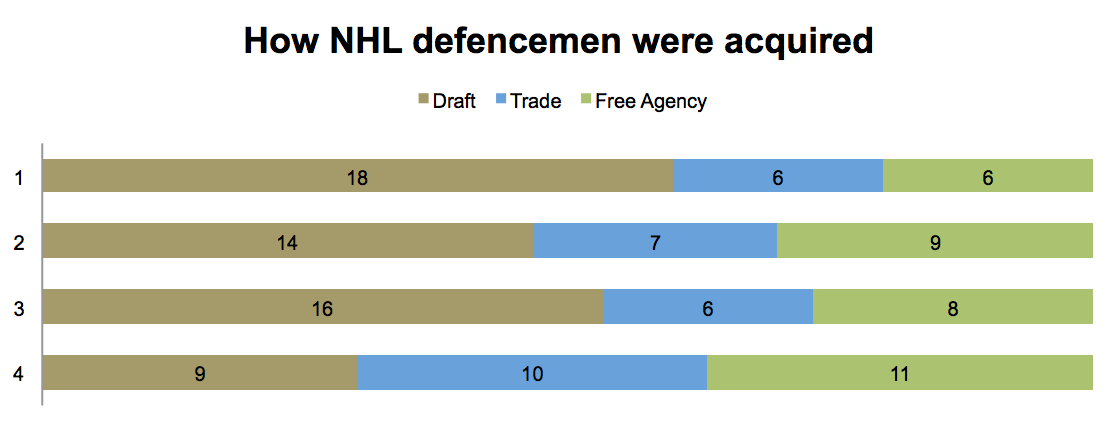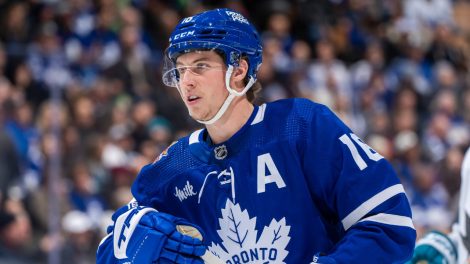It has become cliché to say that it’s hard to find a good defenceman in the NHL. That belief obscures a far more interesting and useful truth: Good defencemen are often available, and at a far lower acquisition cost than they should be.
The reason would appear to be that NHL teams are still sorting out for themselves what makes a good defenceman.
Brent Burns is a good example of the trend. Burns, a second-team all-star last season and the most-used defenceman on the San Jose Sharks, was traded at the age of 26, right in the heart of his career.
It’s tempting to think the Wild didn’t know what they were giving up, but given that Burns had scored 17 goals and averaged more than 25 minutes per game the year they traded him, it’s hard to excuse the deal in which they acquired Charlie Coyle. Burns also dramatically outperformed the Wild average in terms of shot metrics (Corsi and Fenwick). Even the Sharks, beneficiaries of the deal, took years to realize Burns was best as a defenceman rather than a right winger.
Anton Stralman is another famous recent example of miscalculation by an NHL team. An analytics darling going back to his time in Columbus, he bounced around the league and was let go by the New York Rangers in the summer of 2014. Tampa Bay signed him to a five-year deal as an unrestricted free agent at the insanely low cap hit of $4.5 million, and he’s been an exceptional top-pair defender with the Bolts ever since.
Montreal’s Jeff Petry fits the bill, too. His career started in Edmonton and from a young age he had the thankless job of playing top-pairing matchups on the worst team in the NHL. That obscured his value and at the 2015 trade deadline the Canadiens were able to get him for a song (a second-round pick). He’s now playing all situations and more than 22 minutes per night as that team’s second most-used defender.
If these sound like aberrations, they are not. Most defencemen playing top-four minutes in the league today were acquired via trade or free agency, rather than being homegrown prospects their teams developed.
Here’s a look at how every defender playing top four minutes in the NHL was acquired by their current team:

No. 1 defencemen are the hardest players to acquire, but they can be had. Sometimes, it involves a willingness to pony up cash, as was the case with Ryan Suter in Minnesota and Zdeno Chara in Boston. Other times, it’s a function of the salary cap. Salary concerns forced Chicago to part with Dustin Byfuglien and Nick Leddy, both of whom lead their current teams in average ice-time.
Outside that No. 1 position, NHL teams really don’t have much excuse for failure to find talent. Half of all No. 2-3 defencemen landed with their current teams after a trade or July 1 signing — and more than two-thirds of No. 4 defencemen were not drafted by their current teams.
The difficulty isn’t that players aren’t available. The real trouble is figuring out which players will be able to handle top-four minutes, identifying the Petrys and Stralmans and separating them from poorer contracts like the ones handed to Kevin Bieksa or Brooks Orpik.
The obvious name out there right now is Jacob Trouba, the young Winnipeg defenceman who is one of three tremendous right-shot options the Jets have on the back end. Trouba’s shot metrics over his first three NHL seasons point to a player who isn’t a guaranteed No. 1 defenceman, but one who should certainly evolve into a top-pair guy and might end up being a cornerstone piece.
Another commonly cited name as potentially available is Dougie Hamilton, whose shot metrics are incredible. When he’s on the ice, Calgary out-shoots the opposition 55-45 (shots and missed shots); when he’s off the ice the Flames get out-shot 54-46 by the same metric. He’s big, fast and an excellent offensive player.
Anaheim has a surplus of defencemen, particularly with Shea Theodore constantly pushing for minutes. Something has to give there and increasingly it looks like Cam Fowler won’t be the one to move. Either Hampus Lindholm or Josh Manson would be a great addition to any NHL blue line, with Lindholm in particular boasting underlying numbers that scream elite-level talent.
On the cheap side of the spectrum, Edmonton’s Brandon Davidson is an interesting possibility. He is young, was excellent in any situation last season, boasts a varied skillset and is an obvious potential casualty to expansion. The trouble with him is that there isn’t a long track record to assess.
Free agency is pretty shallow past the obvious names (Kevin Shattenkirk, Karl Alzner) but Cody Franson remains intriguing. He has obvious weaknesses (speed) but he’s big, has long experience against tough opponents and has offensive abilities that haven’t been given much of a chance buried behind Rasmus Ristolainen and Zach Bogosian. On a low-risk contract, Franson could very well impress.
The point in all of this is that there are defensive options out there. It’s just a matter of finding them.









